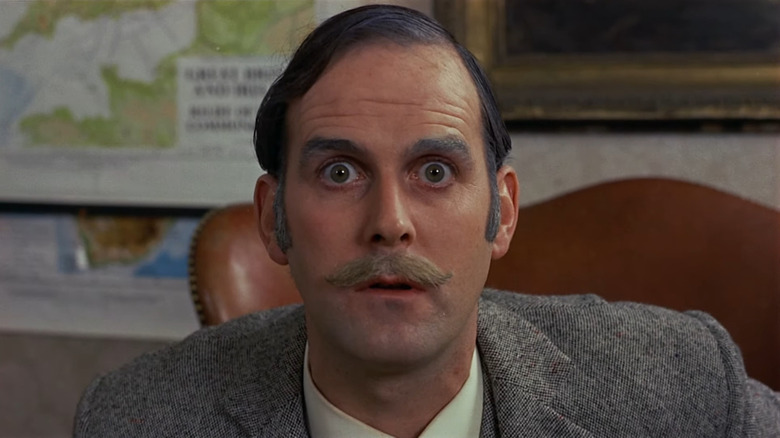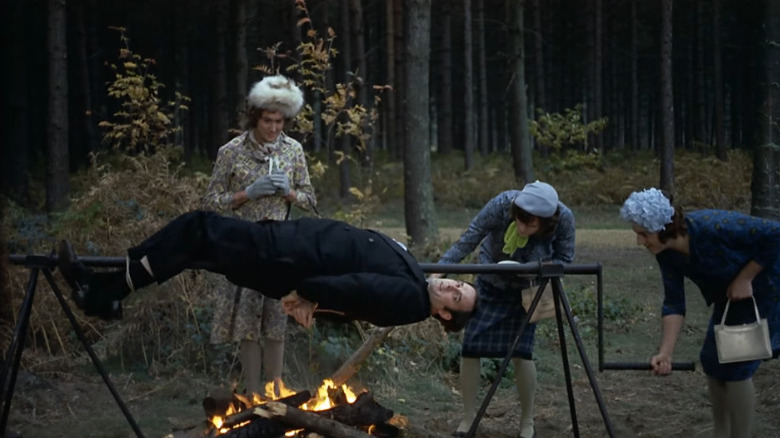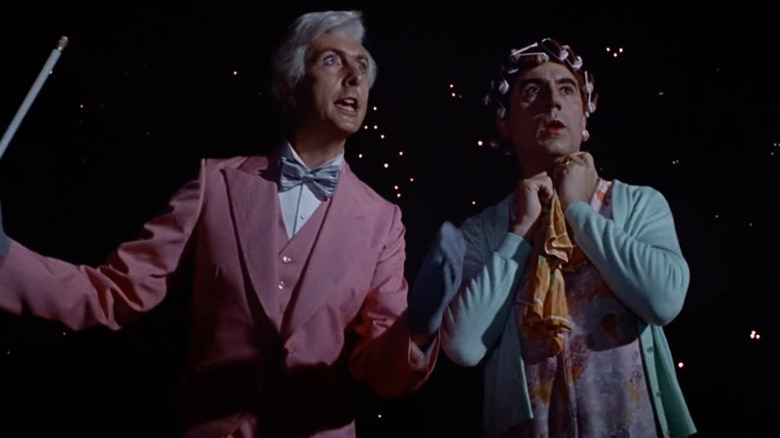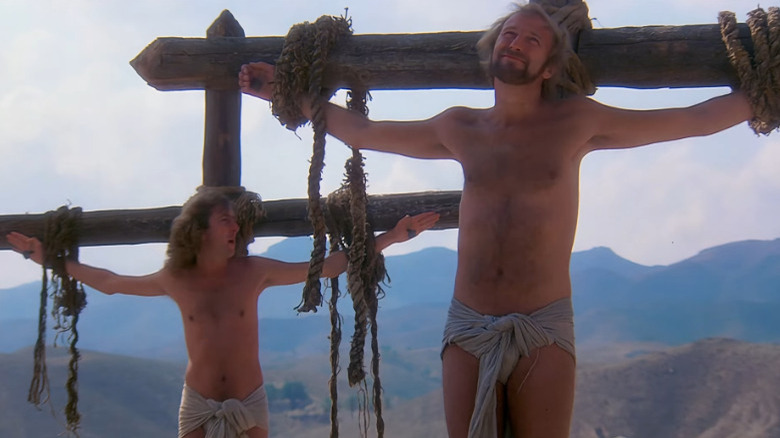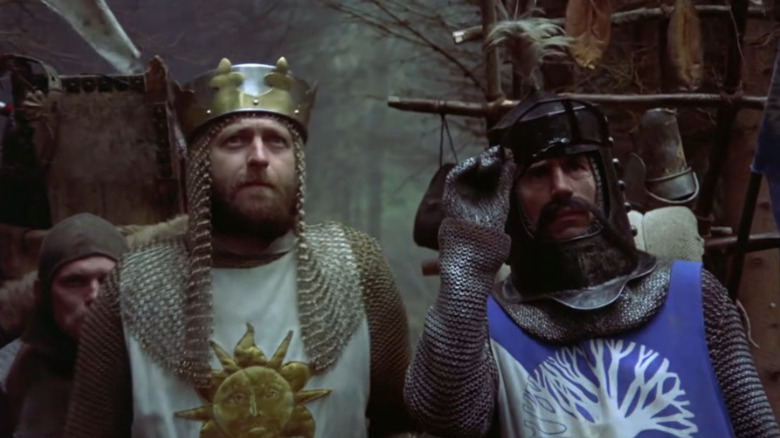Every Monty Python Movie Ranked
It's nothing short of a miracle that anything nearly as weird as "Monty Python's Flying Circus" became a pop culture phenomenon. In the BBC television series that ran from 1969 to 1974, comedians Graham Chapman, John Cleese, Eric Idle, Terry Jones, and Michael Palin, along with animator Terry Gilliam and frequent co-stars Carol Cleveland and Connie Booth, obliterated all sense of sanity on the airwaves.
Their sketch comedy show — which had neither circuses, pythons, nor a character named "Monty" — crafted off-the-wall sketches about every strange thing they could think of. Silly walks, Hungarian phrase books, and how not to be seen were just the tip of the very absurd iceberg, and the comedy troupe's absolute dedication to defying convention remains, to this day, a gold standard to which any comedian can aspire.
Monty Python didn't stay on the airwaves forever. The troupe created four feature films together over the course of twelve years, in addition to a variety of side projects that featured multiple members of the group, and live performances that were filmed and released separately. Today we're going to take a look back at their four official features and see what they're made of, how they work, and which ones are the best actual films. (We're not going to bother with which one is the funniest because, let's face it, they are all very, very funny.)
4. And Now For Something Completely Different (1971)
The Dadaist comedy troupe's first movie is an oddity, even for them. "Monty Python's Flying Circus" had only been on the air for two seasons, or "series," when the decision was made to repackage their very best sketches — including timeless classics like "Nudge Nudge," "The Funniest Joke in the World," and "The Dead Parrot" — as a feature film to introduce them to American audiences instead of merely distributing the series and hoping for the best.
It's a cheap movie, and it could have been made even cheaper if they had merely edited all the pre-existing sketches together. Instead, the live-action sketches in "And Now For Something Completely Different" — named after a phrase the comedians used to segue between entirely unrelated sketches, which is repeated often in the film — were completely reshot for the movie, leaving fans with some minor debate between which versions of the sketches are better: The ones from the "And Now For Something Completely Different," or the ones from "Flying Circus."
Fortunately, the argument is moot: "And Now For Something Completely Different" loses a lot of points for its redundancy, but the sketches successfully make the transition from the TV screen to the silver screen. Anyone looking to take a crash course in Pythonesque humor will no doubt laugh at most or all the material, even though it's barely scratching the surface of their work.
3. Monty Python's The Meaning of Life (1983)
In some respects "The Meaning of Life" is Monty Python's biggest and most ambitious production, and in other ways it feels remarkably slipshod. It's not just a title: Monty Python really does aim to explore the vast complexities of human existence from conception to the afterlife and beyond, and in blisteringly funny and impressive comedy routines about why "Every Sperm is Sacred" and why every day is "Christmas in Heaven," they come surprisingly close to their goal.
On the other hand, "Monty Python's The Meaning of Life" doesn't successfully justify why some of its sketches are included in a film that, ostensibly, has a grandiose point. The abjectly horrifying fate of Mister Creosote — a stout gentlemen who eats so much he literally explodes — is amusing in its presentation, if not exactly kind to larger people, and culminates in a sight gag that's truly grotesque, perhaps to a fault. It just doesn't have anything meaningful to do with "The Meaning of Life."
Still, hilarious set pieces involving the physical manifestation of Death and some rather unfortunate salmon mousse, and of course the machine that goes "Ping!", make up for the film's not-always-successful sketches structure. And the final revelation of the actual meaning of life — seriously, Monty Python actually tells us the meaning of life, it's not a gag — is surprisingly reasonable and hard to disagree with.
2. Monty Python's Life of Brian (1979)
Monty Python's most controversial film still feels daring today, sometimes for the right reasons, sometimes for the wrong ones. "Life of Brian" tells the story of Brian (Graham Chapman), who was coincidentally born the same night as Jesus Christ, in the manger next door. His life story also happens to parallel Christ's in many ways, from his ascension to a religious leader, to his eventual — and in Brian's case, completely unintentional — martyrdom.
The argument that "Life of Brian" is offensive to Christians is a bit odd, because the film is very kind to Jesus Christ, only depicting him once, reverently giving the Sermon on the Mount. The joke is his words aren't misinterpreted centuries later, but misinterpreted immediately by audience members standing in the back who think he's saying "blessed are the cheesemakers" and "the Greek will inherit the Earth."
The irony, of course, is that "Life of Brian" — which, despite its classic sequences, has its flaws, and sometimes picks on cruel targets — is itself often misinterpreted. A scene where a character reveals themselves to be a trans woman, only to be berated by an ignorant a-hole who doesn't get it, has recently been cited by transphobes as a justification for their hatred. But the film's point is that, again, the guy who doesn't get it is an ignorant a-hole, and even he comes around by the end because it's none of his damn business how anyone else lives their life.
"Life of Brian" concludes with one of cinema's great set pieces: A joyfully ironic scene where Brian is crucified, and everyone strapped to a cross sings Eric Idle's most iconic song, "Always Look on the Bright Side of Life." It's a perfect encapsulation of the simultaneous miseries and wonders of human existence, and while the film may be aging awkwardly, that ending is Monty Python at its best.
1. Monty Python and the Holy Grail (1975)
Monty Python's first narrative feature is one of the most quoted comedies ever filmed, and also one of the smartest. "The Holy Grail" uses Arthurian legends to explore the British national identity, its reverence and its hypocrisies, its history and its foibles. For a film where a rabbit rips out people's throats, and where they use coconuts instead of horses (because in reality, Monty Python couldn't afford real horses), every scene feels like the result of scrupulous historical research and intelligent, subversive dissections of the oft-told tales of King Arthur and his knights.
Graham Chapman stars as King Arthur, who assembles his Knights of the Round Table but decides not to go back to Camelot ("it is a silly place"), and instead takes a mission from God to find the Holy Grail. Along the way, they split up and endure a series of misadventures involving tenuous vows of chastity, mass murders at arranged marriages, and of course ... a shrubbery! (Sting music.)
Meanwhile, co-directors Terry Jones and Terry Gilliam are masterfully playing with the cinematic form, using the opening credits as a canvas for fourth-wall shattering gags, ending special effects sequences because the animator happened to have a heart attack, and turning the tiniest joke from the beginning of the film into a gigantic deus ex machina just so they don't have to craft a real ending.
Ingenious and still just as funny as ever, "Monty Python and the Holy Grail" is the troupe's most successful motion picture. There may be highlights in their other films that briefly surpass "The Holy Grail" in their conception or whimsy, but none of them still work as wonderfully as a complete film.
